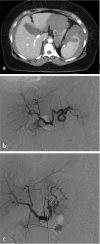Splenic artery embolization in the treatment of blunt splenic injury: single level 1 trauma center experience
- PMID: 38988193
- PMCID: PMC12239535
- DOI: 10.4274/dir.2024.242789
Splenic artery embolization in the treatment of blunt splenic injury: single level 1 trauma center experience
Abstract
Purpose: To describe the experience of a single level 1 trauma center in the management of blunt splenic injuries (BSI).
Methods: This is a retrospective study with Institutional Review Board approval. The medical records of 450 patients with BSI treated between January 2016 and December 2022 were reviewed. Seventy-two patients were treated with splenic artery embolization (SAE), met the study criteria, and were eligible for data analysis. Spleen injuries were graded in accordance with the American Association for the Surgery of Trauma Organ Injury Scale. Univariate data analysis was performed, with P < 0.05 considered statistically significant.
Results: The splenic salvage rate was 90.3% (n = 65/72). Baseline demographics were similar between the groups (P > 0.05). Distal embolization with Gelfoam® had similar rates of splenic salvage to proximal embolization with coils (90% vs. 94.1%, P > 0.05). There was no significant difference in the rate of splenic infarction between distal embolization with Gelfoam® (20%, 4/20) and proximal embolization with coils (17.6%, 3/17) (P > 0.05). There was no significant difference in procedure length (68 vs. 75.8 min) or splenic salvage rate (88.5% vs. 92.1%) between proximal and distal embolization (P > 0.05). There was no significant difference in procedure length (69.1 vs. 73.6 min) or splenic salvage rate (93.1% vs. 86.4%) between Gelfoam® and coil embolization (P > 0.05). Combined proximal and distal embolization was associated with a higher rate of splenic abscess formation (25%, 2/8) when compared with proximal (0%, 0/26) or distal (0%, 0/38) embolization alone (P = 0.0003). The rate of asymptomatic and symptomatic splenic infarction was significantly higher in patients embolized at combined proximal and distal locations (P = 0.04, P = 0.01).
Conclusion: The endovascular management of BSI is safe and effective. The overall splenic salvage rate was 90.3%. Distal embolization with Gelfoam® was not associated with higher rates of splenic infarction when compared with proximal embolization with coils. Combined proximal and distal embolization was associated with a higher incidence of splenic infarction and splenic abscess formation.
Clinical significance: Distal splenic embolization with Gelfoam® is safe and may be beneficial in the setting of blunt splenic trauma.
Keywords: Coil; Gelfoam®; combined; distal; embolization; proximal; spleen; trauma.
Conflict of interest statement
Bahri Üstünsöz, MD, is Section Editor in Diagnostic and Interventional Radiology. He had no involvement in the peer-review of this article and had no access to information regarding its peer-review. Alison A. Smith is a paid consultant for Aroa Biosurgery and on the advisory board for Prytime Medical Devices. Other authors have nothing to disclose.
Figures




References
-
- Lukies M, Zia A, Kavnoudias H, et al. Immune function after splenic artery embolization for blunt trauma: long-term assessment of CD27(+) IgM B-cell levels. J Vasc Interv Radiol. 2022;33(5):505–509. - PubMed
MeSH terms
LinkOut - more resources
Full Text Sources
Miscellaneous

